Zoom
Trash

The Science of Blended Learning – a research-practice partnership. Like all areas of life, last year was a challenging one in education but it was also a year of important learning and growth – and not just for students!

The shift to remote learning required educators to change how they approached learning and teaching, with the majority of schools moving to some form of online learning and teaching program. For some schools, this shift was a radical change, whilst for others it was an acceleration of ideas and practices already in place. Either way, for many it led to new conversations about the possibilities of Blended Learning as a more integral aspect of regular learning and teaching programs. Blended Learning in a school context Blended Learning involves the combination of face-to-face, non-digital learning with supportive digital or online activities. Understandably, much discussion has since followed about the future of education, with some pertinent questions emerging, such as: Edutopia. School 21 infuses the arts into a project-based learning model, emphasizing personalized learning and redrafting multiple revisions in the process of iteration.
This London-based public school teaches students from Reception through Year 11 (approximately pre-K to 11th grade), and will ultimately serve through Year 13. At the secondary level (Years 7 through 11), each PBL unit is co-taught by a core academic subject teacher and an arts teacher. School 21 believes that integrating the arts and PBL is a natural fit. "I would argue that the arts is project-based learning," says Emily Crowhurst, a music teacher. "In every music lesson, whether it's a project lesson or what you might deem a typical lesson, there are project-based learning techniques going on naturally in the way that students are constantly critiquing and rehearsing what they're creating; and they're always working towards an end project that will have an authentic audience.
" Edutopia. Discover Benefits of Community and Business Partnerships How Can High-Poverty Schools Engage Families and the Community?
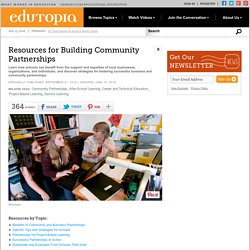
: Learn about the benefits when high-poverty schools engage with community partners for support, resources, and guidance. (Edutopia, 2016) What Community Engagement in Education Looks Like . . . and Can Do: Find how how business and community involvement can make a difference for students and schools. (Edutopia, 2015) Internships and Service Learning From Research Review on Integrated Studies: Examine the research literature on specific benefits of internships and service learning and the role community plays.
Edutopia. Project-based learning (PBL) demands excellent assessment practices to ensure that all learners are supported in the learning process.
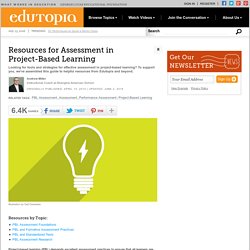
With good assessment practices, PBL can create a culture of excellence for all students and ensure deeper learning for all. We’ve compiled some of the best resources from Edutopia and the web to support your use of assessment in PBL, including information about strategies, advice on how to address the demands of standardized tests, and summaries of the research. Edutopia.
Edutopia. Project-based learning (PBL) naturally lends itself to differentiated instruction.

By design, it is student-centered, student-driven, and gives space for teachers to meet the needs of students in a variety of ways. PBL can allow for effective differentiation in assessment as well as daily management and instruction. PBL experts will tell you this, but I often hear teachers ask for real examples, specifics to help them contextualize what it "looks like" in the classroom. Service Learning: Growing Action From the Roots of Passion.
In 2007, my co-teacher and I noticed that students felt increasingly like the world was "happening to them," as if they had no ability to affect positive change.
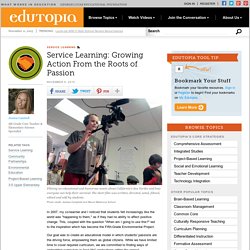
This, coupled with the question "When am I going to use this? " led to the inspiration which has become the Fifth-Grade Environmental Project. Our goal was to create an educational model in which students' passions are the driving force, empowering them as global citizens. PBL and STEAM Education: A Natural Fit. Both project-based learning and STEAM education (science, technology, engineering, art and math) are growing rapidly in our schools.
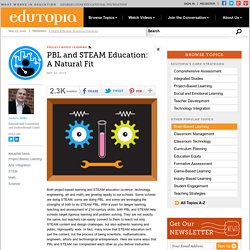
Some schools are doing STEAM, some are doing PBL, and some are leveraging the strengths of both to do STEAM PBL. With a push for deeper learning, teaching and assessment of 21st-century skills, both PBL and STEAM help schools target rigorous learning and problem solving. They are not exactly the same, but teachers can easily connect to them to teach not only STEAM content and design challenges, but also authentic learning and public, high-quality work.
In fact, many know that STEAM education isn't just the content, but the process of being scientists, mathematicians, engineers, artists and technological entrepreneurs. Edutopia. When looking at how engaged students are in playing games, it makes sense to capture some of the ideas that game designers use to engage the player.
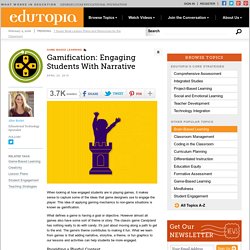
This idea of applying gaming mechanics to non-game situations is known as gamification. What defines a game is having a goal or objective. However almost all games also have some sort of theme or story. The classic game Candyland has nothing really to do with candy. It's just about moving along a path to get to the end. Providing a Playful Context In addition to adding to the fun of the activity, having a story can provide context for student learning.
To get started, try including a paragraph with each assignment that tells a little story. Edutopia. Times of flux should signal the A-OK for some experimentation in schools.
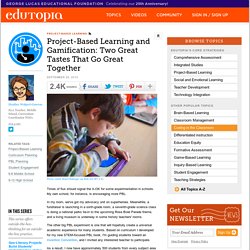
My own school, for instance, is encouraging more PBL. In my room, we've got my advocacy unit on superheroes. My PBL Failure: 4 Tips for Planning Successful PBL. I went into my second PBL unit with the intention of making it something that my students would find more interesting than our first project.

Not that our first was uninteresting, but this time I wanted to focus on a topic that would really drive their interest. Our first project, filmmaking, had kept them interested. The subject of their films, recycling, hadn't been the driving force for them. I hoped that our second PBL experience would combine an interesting topic and work to keep them engaged. However, despite this goal, that second unit turned into what my students might call an "epic fail. " The Project There were multiple "fails" with this project, but the biggest was interest.
When I introduced the guiding question, "Who Am I, Really? I made three big mistakes that impacted the success of my project: Edutopia. You know the hardest thing about teaching with project-based learning?
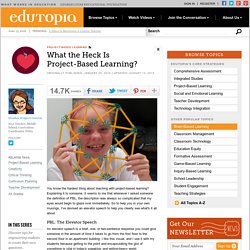
Explaining it to someone. It seems to me that whenever I asked someone the definition of PBL, the description was always so complicated that my eyes would begin to glaze over immediately. So to help you in your own musings, I've devised an elevator speech to help you clearly see what's it all about. PBL: The Elevator Speech An elevator speech is a brief, one- or two-sentence response you could give someone in the amount of time it takes to go from the first floor to the second floor in an apartment building. A Project-Based Learning Spectrum: 25 Questions To Guide Your PBL Planning.
A Project-Based Learning Spectrum: 25 Questions To Guide Your PBL Planning by Terry Heick I’ve been talking with a friend recently about project-based learning, which is leading to a TeachThought Project-Based Learning framework hopefully sometime next week. (Or whenever I finally get this TeachThought podcast off the ground–maybe Tuesday? Edutopia. What does the effective implementation of project-based learning (PBL) look like within a school or across an entire system? There's no one right answer, according to superintendents and school leaders who have started down this path.
Some leaders want to see wall-to-wall PBL, with students learning mainly through projects in every subject. Others set a more realistic goal, hoping to see students taking part in projects at least a few times during the school year. For strategic reasons, leaders may choose to concentrate PBL rollouts in certain subject areas, such as STEM, or launch PBL initiatives at specific grade levels or pilot sites. Whether the goal is for projects to happen occasionally or every day, in one building or across an entire school system, lasting results require thoughtful leadership.
Edutopia. Editor's Note: Matt Weyers and co-author Jen Dole, teachers at Byron Middle School in Byron, Minnesota, present the seventh installment in a year-long series documenting their experience of launching a PBL pilot program. Project-based learning is a complex teaching method that, in our experience, requires a clear and established workflow to seamlessly accommodate the needs of teachers, parents, and students. Throughout this school year, we have found several apps, add-ons, and programs that have helped us best manage our workflow.
Before we provide brief descriptions and links to each of them, it is important to state the current situation in our classroom: Students in our classes have individual iPads to use during the school day (they stay at school). Every student has a school-generated Gmail account. Favorite Tool #1: Google Apps The Google Apps suite is an invaluable tool in our classroom. Resources for Assessment in Project-Based Learning. Edutopia. Time to Debunk Those PBL Myths. What are the myths you hear most often about project-based learning? Here are some PBL misconceptions I encounter with surprising regularity: "Projects may be fun, but they'll never prepare students for ____ [fill in high-stakes test of your choice]" "If kids work in teams on projects, one or two will do all the work and the others will coast" "PBL won't work with my students because they are ____ [fill in the challenge of your choice]" "I'll never have time to cover all my content if I spend time on projects" "Projects just aren't rigorous" "Parents will wind up doing most of the work" "We can't do PBL because we don't have ____ [fill in the technology of your choice]" Once you start listening for PBL myths, you'll hear them in the most surprising places.
During a long flight recently, I was reading to pass the time. I nearly tossed my e-reader when author Liane Moriarty had her adult characters in Big Little Lies scrambling to finish their children's projects. PBL and STEAM Education: A Natural Fit. Edudemic - Education Technology Tips For Students And Teachers. Your Classroom Management and Student Engagement App. How To Get Started With Blended Learning.
Blended learning in the classroom is evolving, this much we know. I can remember back when I was in grade school, the only technical advancement that we had at our disposal was Number Munchers , the computer game designed to teach students basic mathematics skills. Times have certainly changed. Today, blended learning in the classroom is becoming more of a norm than an exception.
Grade school students have never known life without the flashy gizmos and gadgets that break down the walls of learning. Mobile devices, slick APIs, social platforms, and the like are ingrained in the psyche of today’s youth – teachers who fail to take advantage of these trends are missing a tremendous opportunity to enrich their learning experiences. How Teachers Are Using Blended Learning Right Now. The Importance Of The Evolution Of Education 6.34K Views 0 Likes Over the past century, the modes of both imparting and receiving education have undergone a paradigm shift. The evolution of education has become more important than ever. What Exactly Is Blended Learning? We’ve been discussing blended learning on Edudemic for several months but I had been struggling to find a video that helps explain what it actually is and why you should care. Then I happened upon one of the startups I’ve been watching. What Is Blended Learning? These Videos Will Get You Started.